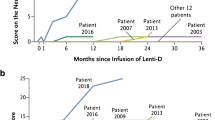Abstract
Approximately one third of boys with X-linked adrenoleukodystophy (X-ALD) develop an acute, progressive inflammatory process of the central nervous system, resulting in rapid neurologic deterioration and death. Hematopoietic cell transplantation (HCT) can halt the progression of neurologic disease if performed early in the course of the cerebral form of X-ALD. We describe a retrospective cohort study of 90 boys with X-ALD evaluated at our institution between 2000 and 2009, to determine if early diagnosis of X-ALD following the diagnosis of unexplained adrenal insufficiency (AI) improves outcomes. We describe seven cases with a delay in the diagnosis of X-ALD and compare their outcomes to ten controls with the diagnosis of ALD made within 12 months following diagnosis of AI. At the time of evaluation for HCT, boys with a delay in the diagnosis of X-ALD had more extensive cerebral involvement and more limited functioning. These boys also were 3.9 times more likely to die and had significant advancement of cerebral disease after HCT, compared with boys with a timely diagnosis of X-ALD. In conclusion, the early diagnosis of cerebral X-ALD following the diagnosis of unexplained AI, and subsequent treatment with HCT improves both neurological outcomes and survival in boys with cerebral X-ALD.


Similar content being viewed by others
References
Aubourg P (1997) The expanding world of primary adrenal insufficiencies. Eur J Endocrinol 137:10–12
Baumann M, Korenke GC, Weddige-Diedrichs A et al (2003) Haematopoietic stem cell transplantation in 12 patients with cerebral X-linked adrenoleukodystrophy. Eur J Pediatr 162:6–14
Berger J, Gartner J (2006) X-linked adrenoleukodystrophy: clinical, biochemical and pathogenetic aspects. Biochim Biophys Acta 1763:1721–1732
Bezman L, Moser AB, Raymond GV et al (2001) Adrenoleukodystrophy: incidence, new mutation rate, and results of extended family screening. Ann Neurol 49:512–517
Dubey P, Raymond GV, Moser AB et al (2005) Adrenal insufficiency in asymptomatic adrenoleukodystrophy patients identified by very long-chain fatty acid screening. J Pediatr 146:528–532
Hwu WL, Chien YH, Liang JS et al (2003) Adrenoleukodystrophy initially diagnosed as idiopathic Addison’s disease in two patients: the importance of early testing. J Formos Med Assoc 102:510–513
Korenke GC, Roth C, Krasemann E et al (1997) Variability of endocrinological dysfunction in 55 patients with X-linked adrenoleucodystrophy: clinical, laboratory and genetic findings. Eur J Endocrinol 137:40–47
Krivit W, Aubourg P, Shapiro E et al (1999) Bone marrow transplantation for globoid cell leukodystrophy, adrenoleukodystrophy, metachromatic leukodystrophy, and Hurler syndrome. Curr Opin Hematol 6:377–382
Loes DJ, Hite S, Moser H et al (1994) Adrenoleukodystrophy: a scoring method for brain MR observations. AJNR Am J Neuroradiol 15:1761–1766
Mahmood A, Dubey P, Moser HW et al (2005) X-linked adrenoleukodystrophy: therapeutic approaches to distinct phenotypes. Pediatr Transplant 9(Suppl 7):55–62
Mahmood A, Raymond GV, Dubey P et al (2007) Survival analysis of haematopoietic cell transplantation for childhood cerebral X-linked adrenoleukodystrophy: a comparison study. Lancet Neurol 6:687–692
Moser HW (1997) Adrenoleukodystrophy: phenotype, genetics, pathogenesis and therapy. Brain 120(Pt 8):1485–1508
Moser HW, Bergin A, Naidu S et al (1991) Adrenoleukodystrophy. Endocrinol Metab Clin North Am 20:297–318
Moser H, Dubey P, Fatemi A (2004) Progress in X-linked adrenoleukodystrophy. Curr Opin Neurol 17:263–269
Moser HW, Loes DJ, Melhem ER et al (2000) X-Linked adrenoleukodystrophy: overview and prognosis as a function of age and brain magnetic resonance imaging abnormality. A study involving 372 patients. Neuropediatrics 31:227–239
Moser HW, Raymond GV, Koehler W et al (2003) Evaluation of the preventive effect of glyceryl trioleate-trierucate (“Lorenzo’s oil”) therapy in X-linked adrenoleukodystrophy: results of two concurrent trials. Adv Exp Med Biol 544:369–387
Peters C, Charnas LR, Tan Y et al (2004) Cerebral X-linked adrenoleukodystrophy: the international hematopoietic cell transplantation experience from 1982 to 1999. Blood 104:881–888
Ronghe MD, Barton J, Jardine PE et al (2002) The importance of testing for adrenoleucodystrophy in males with idiopathic Addison's disease. Arch Dis Child 86:185–189
Sadeghi-Nejad A, Senior B (1990) Adrenomyeloneuropathy presenting as Addison’s disease in childhood. N Engl J Med 322:13–16
Shapiro E, Krivit W, Lockman L et al (2000) Long-term effect of bone-marrow transplantation for childhood-onset cerebral X-linked adrenoleukodystrophy. Lancet 356:713–718
Tolar J, Orchard PJ, Bjoraker KJ et al (2007) N-acetyl-L-cysteine improves outcome of advanced cerebral adrenoleukodystrophy. Bone Marrow Transplant 39:211–215
Acknowledgments
This work was partially funded by the Children’s Cancer Research Fund, Minneapolis, MN (J.T., P.O.), NIH 5K12RR023247-05 (L.P.), and the Minnesota Medical Foundation (J.T.). Acknowledgement goes to Dr. William Krivit and Dr. Hugo Moser for their pioneering work in the field of ALD, and Dr. Lawrence Charnas for his helpful comments.
Conflict of interest
The authors declare no financial relationship with the organization that sponsored the research.
Author information
Authors and Affiliations
Corresponding author
Additional information
Lynda E. Polgreen and Saydi Chahla contributed equally to this manuscript.
Rights and permissions
About this article
Cite this article
Polgreen, L.E., Chahla, S., Miller, W. et al. Early diagnosis of cerebral X-linked adrenoleukodystrophy in boys with Addison’s disease improves survival and neurological outcomes. Eur J Pediatr 170, 1049–1054 (2011). https://doi.org/10.1007/s00431-011-1401-1
Received:
Accepted:
Published:
Issue Date:
DOI: https://doi.org/10.1007/s00431-011-1401-1




